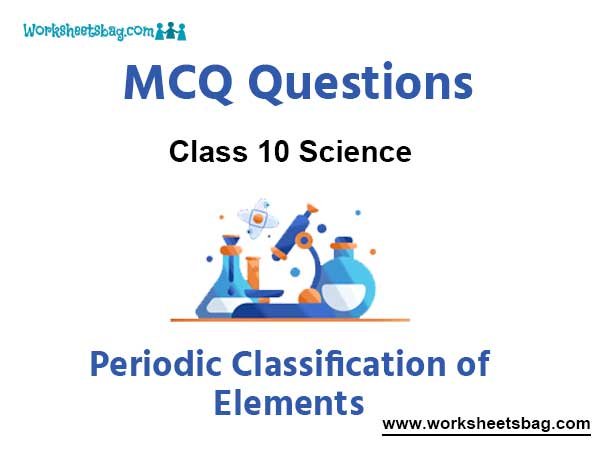Please refer to Periodic Classification of Elements MCQ Questions Class 10 Science below. These MCQ questions for Class 10 Science with answers have been designed as per the latest NCERT, CBSE books, and syllabus issued for the current academic year. These objective questions for Periodic Classification of Elements will help you to prepare for the exams and get more marks.
Periodic Classification of Elements MCQ Questions Class 10 Science
Please see solved MCQ Questions for Periodic Classification of Elements in Class 10 Science. All questions and answers have been prepared by expert faculty of standard 10 based on the latest examination guidelines.
MCQ Questions Class 10 Science Periodic Classification of Elements
Question: elements after actinium is called
a) Lanthanides
b) Actinides b
c) d-block elements
d) p-block elements
Answer
B
Question: Electronic configuration of Al+3 is
a) 2, 8, 3
b) 2, 8, 8
c) 2, 8 c
d) 2, 8, 8, 3
Answer
C
Question: The group number and period number respectively of an element with atomic number 8 is
a) 6, 2
b) 16, 2
c) 6, 8
d) 16, 4
Answer
A
Question: In the third period of the Periodic Table the element having smallest size is
a) Na
b) Ar
c) Cl
d) Si
Answer
B
Question: An element has an atomic number of 15 with which of the following elements will it show similar chemical properties?
a) Be(4)
b) Ne(10)
c) N(7)
d) O((8)
Answer
C
Question: An element belongs to period 2 and group 2 the number of valence electrons in the atoms of this element is
a) 2
b) 4
c) 3
d) 1
Answer
A
Question: Which of the following sets does not belong to a group?
a) Li, Na, K
b) B, C, N
c) B, Al, Ga
d) O, S, Se
Answer
A
Question: The correct order of the increasing radii of the elements Na, Si, Al and P is
a) Si, Al, P, Na
b) P, Si, Al, Na
c) Al, Si, P, Na
d) Al, P, Si, Na
Answer
B
Question: An element with atomic number will form a basic oxide _________.
a) 7
b) 17
c) 14
d) 11
Answer
D
Question: The increasing order of the atomic radii of elements Na, Rb, K, Mg is
a) Na < K < Mg < Rb
b) K < Na < Mg < Rb
c) Na < Mg < K < Rb
d) Mg < Na < K < Rb
Answer
C
Question: Element belonging to which of the following atomic numbers 11, 19, 14, 18, 23 belong to the same period?
a) 11, 14, 23
b) 11, 18, 20
c) 11, 14, 18
d) 14, 19, 23
Answer
C
Question: Which is not true about noble gases?
a) They are non-metallic in nature
b) They exist in atomic form
c) They are radioactive in nature
d) Xenon is the most reactive among these
Answer
C
Question: Which of the given elements A, B, C, D, and E with atomic number 3, 11, 15, 18, 19 respectively belong to the same group
a) A, B, C
b) B, C, D
c) A, D, E
d) A, B, E
Answer
B
Question: Two elements X and Y have – (i) X has 17 protons 18 neutrons (ii) Y has 17 protons and 20 neutrons Both X and Y are –
a) Isobars
b) Isotopes
c) Isotones
d) None of the above
Answer
B
Question: Identify the group which is not a Döbereiner triad
a) Li, Na, K
b) Be, Mg, Cr
c) Ca, Sr, Ba
d) Cl, Br, I
Answer
B
Question: Mendeleev predicted the existence of two elements and named them as eka-silicon and ekaaluminium.Identify the elements which took their position at later stage
a) Si and Ge
b) Si and Ga
c) Ge and Ga
d) Si and Al
Answer
C
Question: An element ‗X‘ is placed in group 13 and third period of the Periodic Table. It burns in oxygen to form an oxide which is amphoteric in nature. Identify the chemical formula of its chloride
a) CCl4
b) BCl2
c) GaCl3
d) AlCl3
Answer
D
Question: The element with atomic number 3 to 10 belongs to the second period. Identify the most electropositive and most electronegative element.
a) F, Li
b) Li, F
c) Li, Ne
d) Ne, Li
Answer
B
Question: In the Modern Periodic Table calcium (Z = 20) is surrounded by the elements with atomic numbers 12, 19, 21, and 38 which of the following will have physical and chemical properties resembling calcium
a) 12, 20, 38
b) 12, 19, 20, 38
c) 19, 20, 38
d) 12, 19, 20
Answer
A
Question: Identify the wrong sequence of the elements in a group
a) Ca, Sr, Ba
b) Cu, Au, Ag
c) N, P, As
d) Cl, Br, I
Answer
B
Question: Two elements X and Y belong to group 1 and 2 respectively in the same period. The formulae of these oxides are
a) XO, YO
b) X 2O, YO
c) X 2O, Y2O
d) XO, YO 2
Answer
B
Question: Which of the following has maximum non-metallic character?
a) F
b) Br
c) Cl
d) I
Answer
A
Question: Arrange the following elements into the increasing order of their metallic character along a period.
a) S < Si < P < Al
b) S < P < Si < Al
c) Si < P < S < Al
d) Si < S < P < Al
Answer
B
Question: In the Modern Periodic Table, the metals among the first ten elements are—
a) Be, Na
b) Li, Be
c) Be, Li, Na
d) Li, Na
Answer
D
Question: Which of the following are not the characteristics of isotopes of an element? Isotopes of an element
a) show same atomic mass
b) show same atomic number
c) occupy same position in the Periodic Table
d) show same chemical properties
Answer
A
Question: An element X (2, 8, 2) combines separately with (SO4)2–and (PO4)3– radicals. The chemical formulae of the compounds are
a) X 2SO4 : X3(PO4)2
b) XSO4 : X3(PO4)2
c) X(SO4)2 : X2(PO4)3
d) XSO4 : X3(PO4)3
Answer
B
Question: Element X forms a chloride with the formula XCl2, which is a solid with a high melting point. X would most likely be in the same group of the Periodic Table as
a) Na
b) Mg
c) Al
d) Si
Answer
B
Question: The element with no definite place in the periodic table is
a) Na
b) H
c) AI
d) Si
Answer
B
Question: In Mendeleev‘s Periodic Table, gaps were left for the elements to be discovered later. Which of the following elements found a place in the periodic table later?
a) Germanium
b) Chlorine
c) Oxygen
d) Silicon
Answer
C
Question: Which of the following is an inert gas?
a) Oxygen
b) Nitrogen
c) Argon
d) Hydrogen
Answer
C
Question: Which of the following statements is not a correct statement about the trends when going from left to right across the periods of periodic table
a) The elements become less metallic in nature.
b) The number of valence electrons increases.
c) The atom loses their electrons more easily.
d) The oxides become more acidic
Answer
C
Question: Which of the following statements is not a correct statement about the trends when going from left to right across the periods of periodic Table?
a) The elements become less metallic in nature.
b) The number of valence electrons increases.
c) The atoms lose their electrons more easily.
d) The oxides become more acidic
Answer
C
Question: Which of the following statement (s) about the Modern Periodic Table are incorrect
i) The elements in the Modern Periodic Table are arranged on the basis of their decreasing atomic number
ii) The elements in the Modern Periodic Table are arranged on the basis of their increasing atomic masses
iii) Isotopes are placed in adjoining group (s) in the Periodic Table
iv) The elements in the Modern Periodic Table are arranged on the basis of their increasing atomicnumber
a) (i) only
b) (i), (ii) and (iii)
c) (i), (ii) and (iv)
d) (iv) only
Answer
B
Question: Which of the given elements A, B, C, D and E with atomic number 2, 3, 7, 10 and 30 respectively belong to the same period?
a) A, B, C
b) B, C, D
c) A, D, E
d) B, D, E
Answer
B
Question: According to Mendeleev’s Periodic Law, the elements were arranged in the periodic table in the order of
a) increasing atomic number
b) decreasing atomic number
c) increasing atomic masses
d) decreasing atomic masses
Answer
C
Question: Where would you locate the element with electronic configuration 2, 8 in the Modern Periodic Table?
a) Group 8
b) Group 2
c) Group 18
d) Group 10
Answer
C
Question: Which of the following gives the correct increasing order of the atomic radii of O, F and N?
a) O, F, N
b) N, F, O
c) O, N, F
d) F, O, N
Answer
D
Question: An element which is an essential constituent of all organic compounds belongs to
a) group 1
b) group 14
c) group 15
d) group 16
Answer
B
Question: Which of the following statements about the Modern Periodic Table is correct:
a) It has 18 horizontal rows known as Periods
b) It has 7 vertical columns known as Periods
c) It has 18 vertical columns known as Groups
d) It has 7 horizontal rows known as Groups
Answer
C
Question: The elements A, B, C, D and E have atomic number 9, 11, 17, 12 and 13 respectively. Which pair of elements belongs to the same group?
a) A and B
b) B and D
c) A and C
d) D and E
Answer
A
Question: Which of the following is the outermost shell for elements of period 2?
a) K shell
b) L shell
c) M shell
d) N shell
Answer
B
Question: Which among the following elements has the largest atomic radii?
a) Na
b) Mg
c) K
d) Ca
Answer
D
Question: Which of the following elements would lose an electron easily?
a) Mg
b) Na
c) K
d) Ca
Answer
C
Question: Which one of the following elements exhibit maximum number of valence electrons?
a) Na
b) Al
c) Si
d) P
Answer
D
Question: Three elements B, Si and Ge are
a) metals
b) non-metals
c) metalloids
d) metal, non-metal and metalloid respectively
Answer
C
Question: Which of the following elements will form an acidic oxide?
a) An element with atomic number 7
b) An element with atomic number 3
c) An element with atomic number 12
d) An element with atomic number 19
Answer
A
Question: Arrange the following elements in the order of their decreasing metallic character Na, Si, Cl, Mg, Al
a) Cl > Si >Al > Mg >Na
b) Na >Mg >Al >Si > Cl
c) Na > Al > Mg > Cl > Si
d) Al > Na> Si > Ca> Mg
Answer
B
Question: What type of oxide would Eka– aluminium form?
a) EO3
b) E3O2
c) E2O3
d) EO
Answer
C
Question: Arrange the following elements in the order of their increasing nonmetallic character –Li, O, C, Be, F
a) F < O < C < Be < Li
b) Li < Be < C < O< F
c) F < O < C < Be < Li
d) F < O < Be < C < Li
Answer
C
Question: Which of the following are the characteristics of isotopes of an element?
i) Isotopes of an element have same atomic masses
ii) Isotopes of an element have same atomic number
iii) Isotopes of an element show same physical properties
iv) Isotopes of an element show same chemical properties
a) (i), (iii) and (iv)
b) (ii), (iii) and (iv)
c) (ii) and (iii)
d) (ii) and (iv)
Answer
B
Question: Which of the following elements does not lose an electron easily?
a) Na
b) F
c) Mg
d) Al
Answer
B
Question: Which one of the following does not increase while moving down the group of the periodic Table?
a) Atomic radius
b) Metallic character
c) Valence
d) Number of shells in an element
Answer
C
Question: On moving from left to right in a period in the periodic table, the size of the atom
a) increases
b) decreases
c) does not change appreciably
d) first decreases and then increases
Answer
B
Question: An element has configuration 2, 8, 1. It belongs to,
a) 1 group and 3rd period
b) 3 group and 1st period
c) 1 group and 8th period
d) 17 group and 3rd period
Answer
A



